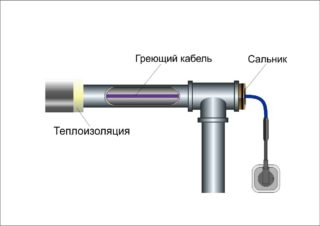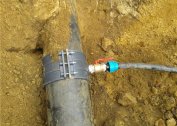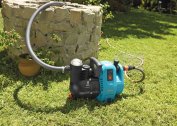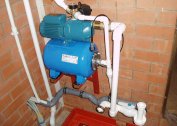Sometimes mistakes occur in the selection of polymer water pipes that can not withstand low temperatures, or laying the trunk to the desired depth does not work out for technical reasons. In this case, the pipeline is heated using a heating cable that connects to the mains. This technique is often used in regions with the lowest winter temperatures to avoid rupture of the pipe or freezing of water inside.
The principle of operation of a self-regulating heating cable for water supply
 Usually, before starting the installation of water pipes, preliminary calculations are carried out - at what depth is the temperature constantly above zero. But there are situations when it is not possible to dig a trench 1.7 meters deep, since on the site groundwater comes close to the surface of the earth. Unfortunately, determining this is not always possible. It happens that local authorities deliberately distribute such land for summer cottages, because they are not suitable for the capital construction of multi-storey buildings. More precisely, it will have to invest a lot of money to drain the site and only then build skyscrapers.
Usually, before starting the installation of water pipes, preliminary calculations are carried out - at what depth is the temperature constantly above zero. But there are situations when it is not possible to dig a trench 1.7 meters deep, since on the site groundwater comes close to the surface of the earth. Unfortunately, determining this is not always possible. It happens that local authorities deliberately distribute such land for summer cottages, because they are not suitable for the capital construction of multi-storey buildings. More precisely, it will have to invest a lot of money to drain the site and only then build skyscrapers.
If pipes are laid in water, this will reduce the resource of their work. In such regions, there is movement of soil, which can deform or even cause cracks in the trunk. It is easier to dig a shallow trench and cover the pipeline with a heating cable.
In addition, there are potentially dangerous areas, for example, at the junction of internal and external water supply. Usually such a segment is located outdoors and requires serious insulation.
The principle of operation of the heating element is to obtain energy and convert it into heat, which is transmitted to the pipe. It can be used both for drinking water pipelines and for sewer highways. Pipes of autonomous sewage are subject to freezing if they are located horizontally and do not have a slope. The presence of a fecal pump to accelerate the flow of liquids does not save the situation, since the pump does not work at night, and the drains inside freeze, which can lead to rupture of the plastic.
Cable heating is especially relevant if the line is located outdoors. This is usually the way water is carried in settlements. The slope here is not observed due to the large length of the highway.
Device and types of cables
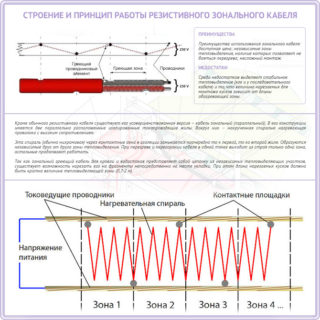 The heating cable is a flat ribbon with parallel conductors. Between them there is an element that accumulates heat and transfers it to the pipe. This is a self-regulating type of heating. Benefits:
The heating cable is a flat ribbon with parallel conductors. Between them there is an element that accumulates heat and transfers it to the pipe. This is a self-regulating type of heating. Benefits:
- The tape can be cut, while maintaining operability.
- If the elements cross over, they do not burn out.
The principle of operation of the self-regulating cable is a constant temperature created by heating cores. Conductors only conduct current, and the plastic element between them is heated. The higher the temperature of the plastic, the less heat transfer to the pipe, and vice versa, if the polymer begins to cool, it gives off more heat. In the process, the cable independently adjusts the temperature. The service life is about 10 years, but it is expensive. If the issue of freezing the water supply is acute, saving is not recommended, since a resistive cable, cheaper, does not have such a working resource.
The principle of the resistive cable is based on the ability of the metal to heat up and give off heat. In this case, the amount of heat is always the same. If on the street –20, there will be little use from such a cable.It is suitable only for regions where the temperature rarely drops below zero.
If during installation, lay resistive wires next to each other or accidentally cross them, most likely they will burn out from overheating. Another minus - you can not use part of the coil of wire. If you buy a wire of a certain length, you must use it all, otherwise it will not work when trimming.
Resistive wires are single and two-core. The second ones are more expensive, but they are bought more often, since this option is more convenient in operation. There is a plug at one end of the two-wire wire, and the other is connected to the mains using a plug. A single-wire cable is connected to the network by both sides, which is not always possible.
The components of any heating wire are:
- Internal veins - one or several. The larger the quantity, the greater the heat generation.
- Protective shell. Aluminum or copper screen and plastic insulation.
- The final sheath is made of polyvinyl chloride.
After laying the cable on the water or sewer pipe, it is still insulated with mineral wool or other materials. In severe frosts, the heat from the cable may not be enough or a large power consumption will be required.
Internal and external cables
Heating cables come in two types - for installation outside or inside the pipe. These characteristics are prescribed in the instructions. Changing the location is prohibited.
The heating cable for the water supply inside the pipe is suitable for products with a diameter of more than 40 mm, since the thickness of the cable will block the movement of water. The installation inside is more complicated, in addition, the surface material must meet the safety criteria, if it is used to heat a pipe with drinking water:
- The shell must be chemically neutral and not release hazardous substances into the water when heated.
- IP protection standards must be observed - not lower than index 68.
- The final shell must be absolutely tight.
Laying the wire on the outside of the pipe is easy. It is necessary to strengthen it with plastic clamps or adhesive tape. It is important to keep the winding uniform. So that the cable does not warm the soil or air, it is covered with a heat-insulating material along with the pipe on top.
Criterias of choice
When choosing a heating cable, the following parameters must be considered:
- Pipe diameter, especially if internal heating is planned.
- Materials and insulation thickness.
- Estimated heat loss.
- The region in which the pipeline is located. The north, the more powerful the cable is required, or you will have to select a serious insulation with a thickness of at least 30 mm.
In the middle lane there is enough power of 10 W / m, in the northern regions you need to buy from 17 W / m.
It makes sense to put a thermostat and sensor so as not to pay too much. For example, resistive cables will work even when the temperature in the street rises above zero. A self-regulating cable for heating a water supply usually turns off at +13 degrees, but if water is supplied from a well, its temperature will always be lower, even in summer. In autumn and spring, it makes no sense to heat the water, which in the house still goes through the heating stage in a boiler or boiler.
The plus of the thermostat is that the cable will not work too much time - it has its own specific resource and it will last longer. It is enough to set the regulator so that the cable disconnects at a temperature of +5 degrees. Under such conditions, the liquid will not freeze, and nothing threatens the pipes.
Mounting Methods
The first way is laying heating wire over the pipe. Work is performed at an air temperature above 15 degrees. After determining the length, the cable is first fastened in several places with adhesive aluminum tape. Ordinary adhesive tape can not be used, as it melts when heated. The laying location is usually chosen arbitrarily, but the masters advise the side-down - for about 4 or 8 hours.After strengthening with aluminum tape, the entire cable is glued all the way over. This ensures a snug fit to the pipe.
Two cables can be laid in parallel, or in a spiral from one coil. Make sure that the cords do not cross - this will lead to overheating and damage to the system. After the heating wire is laid and strengthened, polystyrene is taken and both halves of it are folded around the pipe, wrapped with tape or tape. Polystyrene is the most hardy material that is not afraid of moisture and tolerates temperature changes well. There will be no problems with it, unlike mineral wool, which crumbles after a year of being in the ground.
For internal installation, you need to clearly determine the length of the trunk to be heated. The main thing is not to damage the cable sheath. This method has many disadvantages, but if the pipeline is already laid in the ground, there is simply no other way to use a heating cable.
Do not run the cable through the stop valves.
Advantages and disadvantages of using various types of cables
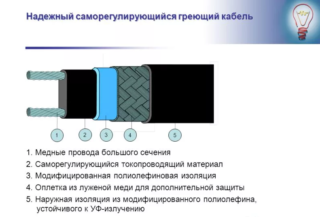 Advantages of self-regulating cable:
Advantages of self-regulating cable:
- Maintains the same temperature regardless of climate.
- It does not heat up and does not burn if several cables intersect.
- It can only be connected on one side.
- Flat shape increases heat dissipation.
- When cutting a piece of the desired length, it retains its properties.
- The degree of isolation allows use in chemically aggressive environments, as well as in explosive places.
The maximum temperature of the self-regulating wire is 65 degrees. Quality products never exceed this limit.
Resistive cable has one advantage - in price, as evidenced by the reviews of dissatisfied owners of water supply and sewage systems. Disadvantages:
- It is heated equally over the entire area - it doesn’t matter that a site needs a higher temperature.
- If overlaps occur, the cable overheats at this point and the entire cable fails. You should accurately calculate the length so that you do not have to think about where to put the rest. You can’t cut it off.
- Low efficiency.
The leader in sales is a self-regulating heating cable, since it has practically no shortcomings, and it is much more economical.
According to consumer reviews, those who put the wire inside the pipe subsequently discovered that dirt had stuck on the winding, and in some places the clots completely blocked the movement of water. In some cases, the winding was exposed to aggressive substances in a liquid and dissolved. At the same time, the system ceased to function.
With external installation, the effect on the winding is completely absent, since the pipe is in the ground and is additionally protected by a polystyrene shell.
The price per meter of electric cable for water supply depends primarily on the materials used in the manufacture. The number of cores inside also affects the cost. Cables of the following manufacturers are represented on the market: Germany, Ukraine, Poland, Czech Republic, Norway and Denmark. You can choose electric cables for water supply for any budget.
Consumer Reviews
Novel: Once the water froze in the pipes, as frosts were below 30 degrees. A week we sat on purchased eggplants. In the summer we decided to put the cable. Since the pipes were already buried, we had to do internal heating. We experienced one season normally. On the second, the system stopped working and the water froze again. It turned out - I bought a cheap cable and he could not stand it. If it’s not lucky, then to the fullest. I again had to carry buckets from the neighbors. Now I bought German, tore up the pipes and stuck on top. They advised to insulate - insulated. Waiting for the winter.
Eugene: The winding was done at the time of laying water and sewage. The wire was glued everywhere, since we live in Chelyabinsk. All the masters did. 5 years have passed - no problems. I don’t understand why to buy cheap stuff for a serious business.
Novel: Eugene, we have here not only smart experts, there are no shops with a choice.What was sold, I bought it, so I got problems already twice.
Sergei: Tell me what to do. Already bought an internal wire, but changed my mind, because I worry that there is electricity in the water. Is it possible to attach it outside?
Basil: It is impossible. They have their own characteristics. Better to sell or take back to the store.
Sergei: Well thank you. But is it possible to buy something cheaper, or 22 meters almost 10,000 rubles? I saw a cable for a warm floor - 1500/22 m is obtained.
